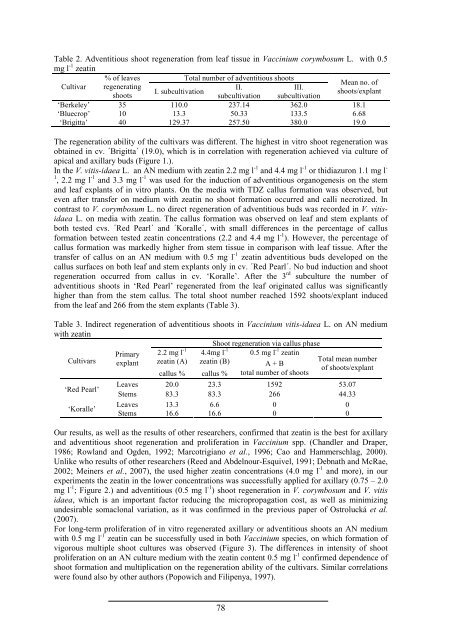Agronomijas v stis - Latvijas LauksaimniecÄ«bas universitÄte
Agronomijas v stis - Latvijas LauksaimniecÄ«bas universitÄte
Agronomijas v stis - Latvijas LauksaimniecÄ«bas universitÄte
You also want an ePaper? Increase the reach of your titles
YUMPU automatically turns print PDFs into web optimized ePapers that Google loves.
Table 2. Adventitious shoot regeneration from leaf tissue in Vaccinium corymbosum L. with 0.5mg l -1 zeatinCultivar% of leavesTotal number of adventitious shootsMean no. ofregeneratingII.III.I. subcultivationshoots/explantshootssubcultivation subcultivation‘Berkeley’ 35 110.0 237.14 362.0 18.1‘Bluecrop’ 10 13.3 50.33 133.5 6.68‘Brigitta’ 40 129.37 257.50 380.0 19.0The regeneration ability of the cultivars was different. The highest in vitro shoot regeneration wasobtained in cv. ´Brigitta´ (19.0), which is in correlation with regeneration achieved via culture ofapical and axillary buds (Figure 1.).In the V. vitis-idaea L. an AN medium with zeatin 2.2 mg l -1 and 4.4 mg l -1 or thidiazuron 1.1 mg l -1 , 2.2 mg l -1 and 3.3 mg l -1 was used for the induction of adventitious organogenesis on the stemand leaf explants of in vitro plants. On the media with TDZ callus formation was observed, buteven after transfer on medium with zeatin no shoot formation occurred and calli necrotized. Incontrast to V. corymbosum L. no direct regeneration of adventitious buds was recorded in V. vitisidaeaL. on media with zeatin. The callus formation was observed on leaf and stem explants ofboth tested cvs. ´Red Pearl´ and ´Koralle´, with small differences in the percentage of callusformation between tested zeatin concentrations (2.2 and 4.4 mg l -1 ). However, the percentage ofcallus formation was markedly higher from stem tissue in comparison with leaf tissue. After thetransfer of callus on an AN medium with 0.5 mg l -1 zeatin adventitious buds developed on thecallus surfaces on both leaf and stem explants only in cv. ´Red Pearl´. No bud induction and shootregeneration occurred from callus in cv. ‘Koralle’. After the 3 rd subculture the number ofadventitious shoots in ‘Red Pearl’ regenerated from the leaf originated callus was significantlyhigher than from the stem callus. The total shoot number reached 1592 shoots/explant inducedfrom the leaf and 266 from the stem explants (Table 3).Table 3. Indirect regeneration of adventitious shoots in Vaccinium vitis-idaea L. on AN mediumwith zeatinShoot regeneration via callus phaseCultivars‘Red Pearl’‘Koralle’Primaryexplant2.2 mg l -1zeatin (A)4.4mg l -1zeatin (B)0.5 mg l -1 zeatinA + Bcallus % callus % total number of shootsTotal mean numberof shoots/explantLeaves 20.0 23.3 1592 53.07Stems 83.3 83.3 266 44.33Leaves 13.3 6.6 0 0Stems 16.6 16.6 0 0Our results, as well as the results of other researchers, confirmed that zeatin is the best for axillaryand adventitious shoot regeneration and proliferation in Vaccinium spp. (Chandler and Draper,1986; Rowland and Ogden, 1992; Marcotrigiano et al., 1996; Cao and Hammerschlag, 2000).Unlike who results of other researchers (Reed and Abdelnour-Esquivel, 1991; Debnath and McRae,2002; Meiners et al., 2007), the used higher zeatin concentrations (4.0 mg l -1 and more), in ourexperiments the zeatin in the lower concentrations was successfully applied for axillary (0.75 – 2.0mg l -1 ; Figure 2.) and adventitious (0.5 mg l -1 ) shoot regeneration in V. corymbosum and V. vitisidaea, which is an important factor reducing the micropropagation cost, as well as minimizingundesirable somaclonal variation, as it was confirmed in the previous paper of Ostrolucká et al.(2007).For long-term proliferation of in vitro regenerated axillary or adventitious shoots an AN mediumwith 0.5 mg l -1 zeatin can be successfully used in both Vaccinium species, on which formation ofvigorous multiple shoot cultures was observed (Figure 3). The differences in intensity of shootproliferation on an AN culture medium with the zeatin content 0.5 mg l -1 confirmed dependence ofshoot formation and multiplication on the regeneration ability of the cultivars. Similar correlationswere found also by other authors (Popowich and Filipenya, 1997).78
















